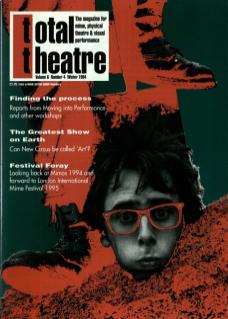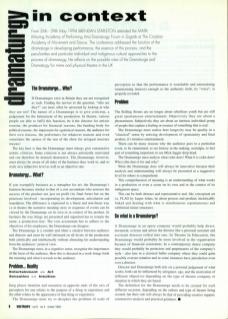The Dramaturg... Who?
If dramaturgs exist in Britain they are not recognised as such. Finding the answer to the question, ‘who are they?’ can more often be answered by looking at who they are not! The nature of a dramaturg is to give criticism, a judgement for the betterment of the production. In theatre, various people are able to fulfil this function, be it the director for artistic reasons, the producer for financial reasons, the funding body for political reasons, the impresario for egotistical reasons, the audience for their own reasons, the performers for whatever reasons, and even sometimes the spouse of the star of the show for arrogant insecure reasons!
The key here is that the dramaturg must always give constructive artistic criticism. Some criticism is not always artistically motivated and can therefore be deemed destructive. The dramaturg, however, must always be aware of all sides of the business they work in, and so work on a subjective level as well as an objective one.
Dramaturgy... What?
If you exemplify business as a metaphor for art, the dramaturg's function becomes similar to that of a cost accountant who assesses the success of the product not just on profit (its final form) but on the processes involved – incorporating its development, articulation and translation. The difference is expressed in a linear and non-linear way, i.e in theatre the narrative, meaning story or sequence of events, can be viewed by the dramaturg on its own or in context of the product. In business the way things are presented and organised has to remain the same, a production line. The cost accountant has to adhere to the objectives of his employers, the dramaturg can disagree.
The dramaturg is a conduit and often a catalyst between audience and director and must be well informed on all levels of the production, both artistically and intellectually, without alienating his understanding from the audience’s point of view.
The dramaturge must, in a cognitive sense, recognise the importance of the focus of the audience. How this is directed in a work brings forth the meaning and what it reveals to the audience.
Problem... Duality
Entertainment Art
Sensation >
Jung places intuition and sensation at opposite ends of the axis of perception, for one relates to the purpose of a thing or experience and the other relates to the appearance of that thing or experience.
The dramaturg must try to decipher the problem of scale of perception so that the performance is watchable and entertaining (maintaining interest) enough so the authentic truth, its ‘voice’ is properly revealed.
Problem
The Rolling Stones are no longer about rebellious youth but are still great spontaneous entertainment. Objectively they are about a phenomenon. Subjectively they are about an intrinsic individual group of people that capture a feeling or essence of something that is real.
The dramaturg must realise here longevity may be quality in a ‘classical’ sense by noticing development of spontaneity and final product, its timeless entertainment.
There can be many reasons why the audience goes to a particular event – to be entertained, to see history in the making, nostalgia, to feel part of something important, to see Mick Jagger drop dead.
The dramaturg must analyse what (s)he does! What it is (s)he does! Who (s)he does it for and why?
What the dramaturg does will always be innovative because their analysis and understanding will always be presented at a suggestive level for others to comprehend.
This comprehension of meaning is an understanding of what works in a production or even a scene on its own and in the context of its indigenous space.
This can be both abstract and representative and, like conceptual art, e.g. Flag by Jasper Johns, be about process and product: inextricably linked and dealing with what is simultaneous (spontaneous) and subliminal (inner structure).
So what is a dramaturg?
A dramaturg in an opera company would probably help direct, document, oversee and advise the director like a personal assistant and assistant director rolled into one. In Theatre in Education, the dramaturg would probably be more involved in the organisation because of financial constraints. In a contemporary dance company they would probably be protectors and perpetuators of the company's style – also true in a classical ballet company where they could quite possibly oversee notation and in some instances have jurisdiction even over a director.
Director and dramaturg both rely on a personal judgement of what works; both can be influenced by arrogance, ego, and the motivation of different objectives depending on the type of theatre company or situation in which they are based.
The definition for the dramaturg needs to be created for each different occasion, depending on the culture and type of theatre being created, but their role will always be that of providing creative support, constructive analysis and practical guidance.

